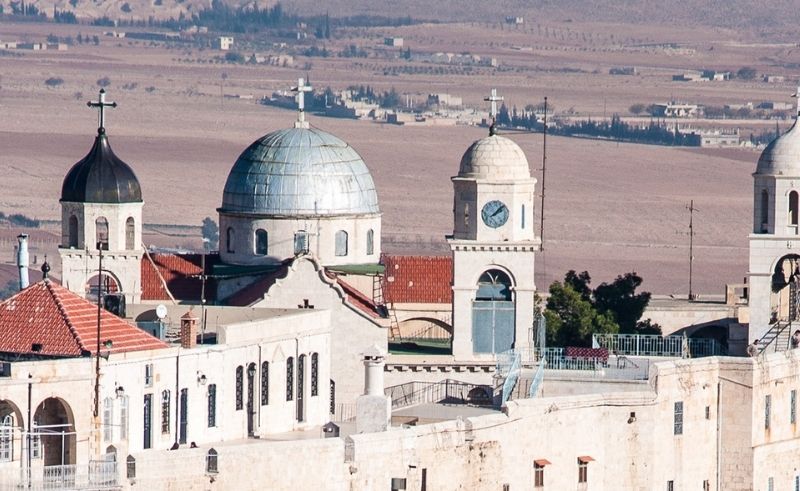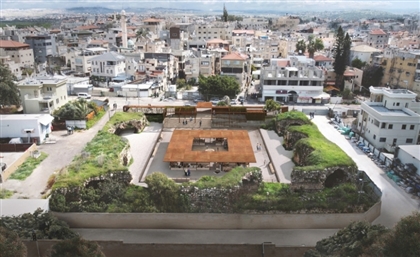This Syrian Monastery Is Where the Virgin Appeared in the Mountains
Built under Emperor Justinian after a vision of the Virgin Mary, the Monastery of Our Lady of Saidnaya remains one of the world’s oldest Christian sanctuaries.

North of Damascus, where the mountains begin to rise and the land turns pale and sharp, lies the town of Saidnaya. The road winds upward through dust and olive groves until the houses appear, stacked into the slope like a spill of white stone. At the highest point stands the Monastery of Our Lady of Saidnaya, one of the oldest surviving Christian monasteries in the world.
-b1edf556-9a83-4e8f-ac3b-ca6a288c124b.jpg) It was founded in the sixth century under Emperor Justinian, who, legend says, was hunting in these hills when the Virgin Mary appeared before him and told him to build a church on this very spot. Whether the story is fact or devotion hardly matters. The monastery exists, and has for nearly 1,500 years, suspended between belief and geography.
It was founded in the sixth century under Emperor Justinian, who, legend says, was hunting in these hills when the Virgin Mary appeared before him and told him to build a church on this very spot. Whether the story is fact or devotion hardly matters. The monastery exists, and has for nearly 1,500 years, suspended between belief and geography.
-4023384b-b2e1-4e3f-a1a9-e6855cdb69b9.jpg) The structure feels almost defensive, built into the mountain as if expecting to outlast everything around it. Courtyards are small and uneven, staircases narrow, the walls thick enough to keep out harsh weather. Inside, a chapel holds the Shaghura: an icon of the Virgin Mary believed to have been painted by Luke the Evangelist. Its silver frame gleams in the dim light, surrounded by chains, crosses, and charms left behind by those who came seeking help.
The structure feels almost defensive, built into the mountain as if expecting to outlast everything around it. Courtyards are small and uneven, staircases narrow, the walls thick enough to keep out harsh weather. Inside, a chapel holds the Shaghura: an icon of the Virgin Mary believed to have been painted by Luke the Evangelist. Its silver frame gleams in the dim light, surrounded by chains, crosses, and charms left behind by those who came seeking help.
-e4448fda-4209-4331-9162-33d679d8bfa3.jpg) Beyond its stone walls, Saidnaya itself is a landscape of devotion; home to more than forty churches, chapels, and monasteries, but none as central as this one. Each year, on September 8th (the Feast of the Virgin Mary), pilgrims arrive from across the Middle East to light candles, offer prayers, and walk the monastery’s narrow corridors in silence. A monumental statue of Jesus rises nearby at the Cherubim Monastery, a quiet sentinel over the pilgrims’ route, and a reminder that faith and stone often rise side by side in these mountains.
Beyond its stone walls, Saidnaya itself is a landscape of devotion; home to more than forty churches, chapels, and monasteries, but none as central as this one. Each year, on September 8th (the Feast of the Virgin Mary), pilgrims arrive from across the Middle East to light candles, offer prayers, and walk the monastery’s narrow corridors in silence. A monumental statue of Jesus rises nearby at the Cherubim Monastery, a quiet sentinel over the pilgrims’ route, and a reminder that faith and stone often rise side by side in these mountains.
-eb9c8250-62f7-4624-aae4-88b02779051d.jpg) Today, the monastery remains active under the Greek Orthodox Patriarchate of Antioch. A handful of nuns live and work here, tending to pilgrims, lighting candles, whispering prayers. There’s no formal tourism; just people who find their way up the mountain, the same way others have done for centuries.
From its terraces, the view stretches across the valley toward Lebanon, the horizon washed in haze. The bells ring slow over the town below, where life carries on much as it always has. During the war, a shell struck one of the cells but didn’t explode. The scar remains, but so does the monastery.
Today, the monastery remains active under the Greek Orthodox Patriarchate of Antioch. A handful of nuns live and work here, tending to pilgrims, lighting candles, whispering prayers. There’s no formal tourism; just people who find their way up the mountain, the same way others have done for centuries.
From its terraces, the view stretches across the valley toward Lebanon, the horizon washed in haze. The bells ring slow over the town below, where life carries on much as it always has. During the war, a shell struck one of the cells but didn’t explode. The scar remains, but so does the monastery.
Trending This Week
-
Dec 23, 2025



























